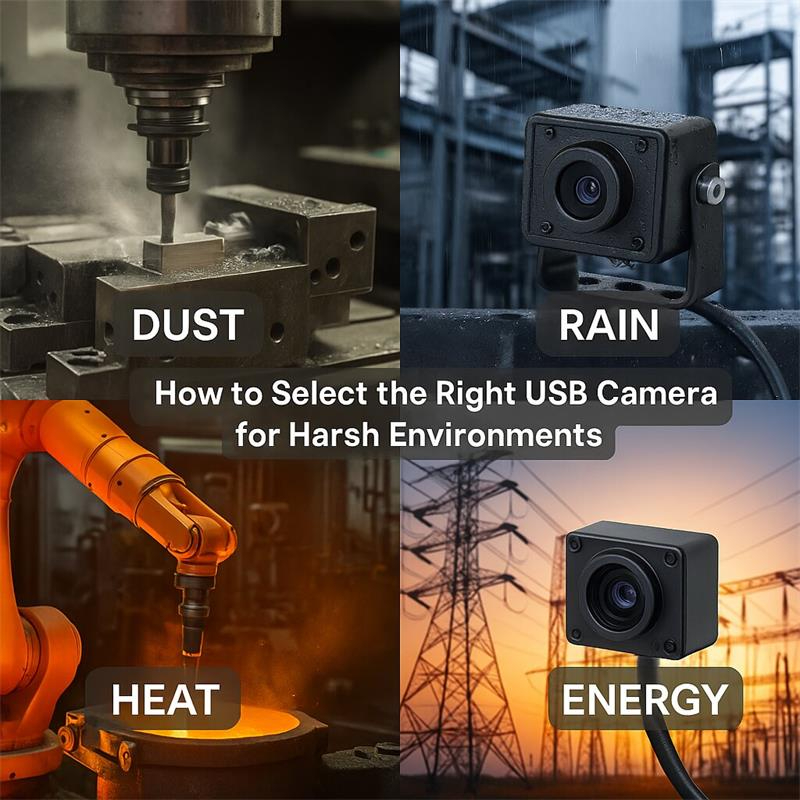Choosing the Right USB Camera for Harsh Environments: A Survival Guide
Industrial settings, outdoor applications, manufacturing floors, dusty workshops, freezing warehouses, or humid labs – these aren't places for your average webcam. When your USB camera needs to survive punishing conditions, selecting the right one is critical. A standard camera might fail within days or hours, costing you downtime, data, and money.
Fear not! This guide will help you navigate the key features and specifications to ensure your USB camera thrives where others merely survive.
1. Define Your "Harsh":
- Physical Impact & Vibration: Is the camera mounted on moving machinery, robots, or vehicles? Will it face knocks or drops?
- Temperature Extremes: How cold does it get? How hot? Think freezers, furnaces, desert sun, or engine compartments.
- Dust & Particulate Matter: Is it a dusty warehouse, a woodshop, or a construction site?
- Moisture & Liquids: Exposure to rain, humidity, splashes, washdowns (high-pressure cleaning), or even submersion?
- Chemical Exposure: Oils, solvents, cleaning agents, or corrosive atmospheres?
- EMI/RFI Interference: Is it near heavy motors, welders, or high-voltage equipment?
2. The Crucial Specs: Environmental Protection
- IP Rating (Ingress Protection): This is non-negotiable.
- IP65: Dust-tight & protected against low-pressure water jets from any direction. Good for most dusty environments and light washdown.
- IP67: Dust-tight & protected against temporary immersion (up to 1m for 30 mins). Ideal for environments needing frequent washdowns or potential splashes.
- IP68: Dust-tight & protected against continuous immersion beyond 1m (depth/time specified by manufacturer). For permanent submersion or extremely heavy washdown.
- IP6K9K: Specifically designed for powerful high-pressure, high-temperature washdowns (common in food & beverage, pharma). Offers superior water jet and steam protection.
- IK Rating (Impact Protection): Measures resistance to mechanical impact. IK08 (5 Joule impact) or IK10 (20 Joule impact) are common for industrial cameras needing protection against knocks or vibration.
- Operating Temperature Range: Check the minimum and maximum temperatures the camera is certified to operate within (not just store!). Industrial cameras often range from -30°C to +60°C or wider (-40°C to +85°C is common for extremes). Ensure it covers your worst-case scenario.
- Humidity Tolerance: Look for specs like "operating humidity up to 95% non-condensing" or higher. Condensation resistance is a bonus.

3. Build Quality & Construction:
- Housing Material: Metal housings (die-cast aluminum, stainless steel) offer superior durability, heat dissipation, and EMI shielding compared to plastic. Stainless steel is king for corrosive environments or food processing.
- Lens Construction: Opt for all-metal lens barrels. Plastic lenses can warp with temperature changes or impact. Look for glass optics for clarity and scratch resistance.
- Connector & Cable:
- Industrial Connectors: Standard USB ports fail under vibration. Seek cameras with:
- M12 Connectors: Circular, threaded, locking connectors. M12 X-coded (USB 3.0/3.1) or M12 A-coded (USB 2.0) are industry standards for vibration resistance and reliability. Often requires a separate cable.
- Strain Relief: Robust strain relief where the cable enters the housing is essential to prevent cable pull-out failures.
- Angled Connectors: Can be very useful in tight spaces.
- Cable Jacket: Look for PUR (polyurethane) cables – they are highly resistant to oils, chemicals, abrasion, and have a wide temperature range. Avoid standard PVC jackets.
4. Performance Considerations for the Environment:
- Sensor & Low Light Performance: Harsh environments often have challenging lighting. Consider:
- Larger Sensors: (e.g., 1/2.8", 1/2.5") capture more light.
- Wide Aperture Lenses: (e.g., F1.8, F2.0) let in more light.
- Good Low-Light Sensitivity: Measured in Lux (lower is better, e.g., 0.1 Lux).
- WDR (Wide Dynamic Range): Essential for scenes with both very bright and very dark areas (e.g., looking out a window in a factory). HDR is a related feature.
- Global Shutter vs. Rolling Shutter: If capturing fast-moving objects without motion blur is critical (like on a conveyor belt), a Global Shutter sensor is vital. Rolling Shutter sensors can cause distortion ("jello effect").
- Resolution & Frame Rate: Choose based on your application's needs (inspection detail vs. monitoring movement). Higher resolutions/frame rates require more bandwidth (USB 3.0/3.1 Gen 1 is often preferred over USB 2.0 for industrial cameras).
5. Mounting & Integration:
- Robust Mounting Options: Look for cameras with standard mounting threads (e.g., 1/4"-20 UNC) integrated into a sturdy housing, or designed for specific industrial brackets/enclosures.
- Size & Form Factor: Does it need to fit into a confined space? Consider board-level cameras (with separate housing) or compact designs.
- Software & Compatibility: Ensure it works with your OS and required software (LabVIEW, OpenCV, HALCON, etc.). Check for SDK availability.
Common Pitfalls to Avoid:
- Ignoring IP Rating: Assuming "rugged" means waterproof or dustproof without checking the specific rating.
- Overlooking Temperature: Not verifying the operating temperature range covers your extremes.
- Standard USB Connectors: Using cameras with fragile USB-A ports in vibrating environments – guaranteed failure point.
- Cheap Cables: Using standard USB cables that degrade quickly with oils, chemicals, or abrasion.
- Focusing Only on Resolution: Sacrificing crucial environmental specs for a few extra megapixels.
Top Recommendations Summary:
- Prioritize IP Rating (IP65/67/68/6K9K) & IK Rating based on your specific threats.
- Demand a Wide Operating Temperature Range that exceeds your needs.
- Insist on Industrial Connectors (M12) and a Robust PUR Cable.
- Choose Metal Housings & Glass Lenses for durability.
- Evaluate Low-Light/WDR Performance if lighting is challenging.
- Consider Global Shutter for high-speed applications.
Investing in the right industrial USB camera upfront saves significant cost, downtime, and frustration in the long run. By carefully matching the camera's rugged specifications to the unique demands of your harsh environment, you ensure reliable vision, critical data capture, and smooth operations where it matters most. Do your homework, scrutinize the specs, and choose a camera built to endure!

